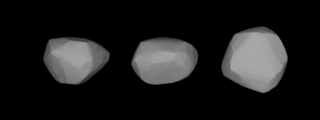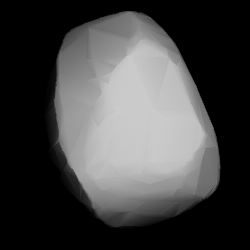
Bellona is a large main-belt asteroid. It was discovered by German astronomer R. Luther on March 1, 1854, and named after Bellōna, the Roman goddess of war; the name was chosen to mark the beginning of the Crimean War. It is a stony (S-type) asteroid with a cross-section size of around 100–120 km. 28 Bellona is orbiting the Sun with a period of 4.63 years.

Atalante is a large, dark main-belt asteroid. It was discovered by the German-French astronomer H. Goldschmidt on October 5, 1855, and named by French mathematician Urbain Le Verrier after the Greek mythological heroine Atalanta. It was rendered 'Atalanta' in English sources in the 19th century. This asteroid is classified as C-type (carbonaceous), according to the Tholen classification system.

Leda is a large, dark main-belt asteroid that was discovered by French astronomer J. Chacornac on January 12, 1856, and named after Leda, the mother of Helen of Troy in Greek mythology. In the Tholen classification system, it is categorized as a carbonaceous C-type asteroid, while the Bus asteroid taxonomy system lists it as a Cgh asteroid. The spectra of the asteroid displays evidence of aqueous alteration.

Kalypso is a large and very dark main belt asteroid that was discovered by German astronomer Robert Luther on April 4, 1858, at Düsseldorf. It is named after Calypso, a sea nymph in Greek mythology, a name it shares with Calypso, a moon of Saturn.

Alexandra is a carbonaceous asteroid from the intermediate asteroid belt, approximately 155 kilometers in diameter. It was discovered by German-French astronomer Hermann Goldschmidt on 10 September 1858, and named after the German explorer Alexander von Humboldt; it was the first asteroid to be named after a male.

Melete is a large and dark main belt asteroid. It is a rather unusual P-type asteroid, probably composed of organic rich silicates, carbon and anhydrous silicates, with possible internal water ice. The asteroid orbits the Sun with a period of 4.18 years.

Frigga is a large, M-type, possibly metallic main-belt asteroid. It was discovered by the German-American astronomer C. H. F. Peters on November 12, 1862. The object is named after Frigg, the Norse goddess. The asteroid is orbiting the Sun with a period of 4.36 years and completes a rotation on its axis every nine hours.

164 Eva is a main-belt asteroid that was discovered by the French brothers Paul Henry and Prosper Henry on July 12, 1876, in Paris. The reason the name Eva was chosen remains unknown. The orbital elements for 164 Eva were published in 1877 by American astronomer Winslow Upton. It is categorized as a C-type asteroid and is probably composed of primitive carbonaceous chondritic materials.

Phthia is a bright-coloured, rocky main belt asteroid that was discovered by German-American astronomer Christian Heinrich Friedrich Peters on September 9, 1878 in Clinton, New York and named after Phthia, a region of Ancient Greece.

Ambrosia is a main belt asteroid that was discovered by the Corsican-born French astronomer J. Coggia on February 28, 1879, and named after Ambrosia, the food of the gods in Greek mythology.

225 Henrietta is a very large outer main-belt asteroid. It was discovered by Austrian astronomer Johann Palisa on April 19, 1882, in Vienna and named after Henrietta, wife of astronomer Pierre J. C. Janssen. The asteroid is orbiting at a distance of 3.39 AU from the Sun with a period of 6.24 years and an eccentricity (ovalness) of 0.26. The orbital plane is inclined at an angle of 20.9° to the plane of the ecliptic. 225 Henrietta belongs to Cybele group of asteroids and is probably in a 4:7 orbital resonance with the planet Jupiter.

Aline is a fairly large main belt asteroid that was discovered by Johann Palisa on 17 May 1887 in Vienna and is thought to have been named after the daughter of astronomer Edmund Weiss. It is a dark C-type asteroid and is probably composed of primitive carbonaceous material. 266 Aline is orbiting close to a 5:2 mean motion resonance with Jupiter, which is located at 2.824 AU.

Eduarda is a main belt asteroid that was discovered by German astronomer Max Wolf on 25 September 1892 in Heidelberg. It was named after German banker and amateur astronomer Heinrich Eduard von Lade.

402 Chloë is a large main-belt asteroid. It was discovered by French astronomer Auguste Charlois on 21 March 1895 from Nice. This asteroid is orbiting the Sun at a distance of 2.56 AU with a period of 4.09 years and an eccentricity of 0.11. The orbital plane is inclined at an angle of 11.8° to the plane of the ecliptic.
Peraga is a minor planet orbiting the Sun that was discovered by German astronomer Paul Götz on January 8, 1905, from Heidelberg.
Cheruskia is a minor planet, specifically an asteroid orbiting in the asteroid belt that was discovered by German astronomer Paul Götz on 26 July 1905 from Heidelberg.
654 Zelinda is a minor planet orbiting the Sun that was discovered on 4 January 1908 by German astronomer August Kopff. On favorable oppositions, it can be as bright as magnitude 10.0, as on January 30, 2016.
678 Fredegundis is a minor planet orbiting the Sun. It was discovered 22 January 1909 from Heidelberg by German astronomer K. Wilhelm Lorenz, and was named after the French opera Frédégonde. This object is orbiting at a distance of 2.57 AU with a period of 4.13 years and an eccentricity (ovalness) of 0.22. The orbital plane is inclined at an angle of 6.1° to the plane of the ecliptic
999 Zachia is a main-belt asteroid that was discovered by German astronomer Karl W. Reinmuth in 1923 and named after Hungarian astronomer Franz Xaver von Zach.

1310 Villigera, provisional designation 1932 DB, is a stony asteroid and large Mars-crosser from the innermost regions of the asteroid belt, approximately 14 kilometers in diameter. It was discovered on 28 February 1932, by German astronomer Friedrich Schwassmann at Bergedorf Observatory in Hamburg, Germany. The asteroid was named after astronomer Walther Villiger.















